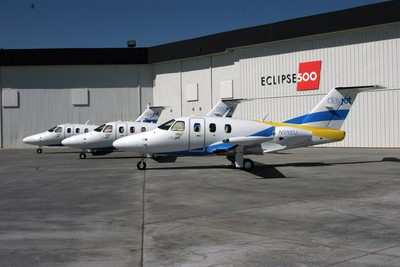Also Notes Accomplishments In Push Towards Full Production
 It's two steps forward, one
step back for Eclipse Aviation. As the company continues to make
progress in ramping up towards full production, and finalizing
performance modifications to the aircraft, Eclipse also
acknowledged a new problem with the aircraft's pitot and
angle-of-attack probe system.
It's two steps forward, one
step back for Eclipse Aviation. As the company continues to make
progress in ramping up towards full production, and finalizing
performance modifications to the aircraft, Eclipse also
acknowledged a new problem with the aircraft's pitot and
angle-of-attack probe system.
In its latest Customer Technical Communication (CTC) -- which is
not a service bulletin -- Eclipse states the issue, which involves
heating elements in the pitot/AOA probes, currently means all
flight operations are limited to visual conditions, accompanied by
an Eclipse company pilot, or Eclipse-trained mentor pilot onboard.
Pilots cannot fly in instrument meteorological conditions (IMC) in
their planes under any circumstances, although pilots may still
file IFR, and operate in the flight levels.
"Eclipse 500 aircraft have experienced three in-flight events in
which pitot pressure was lost on both left and right primary air
data sources, resulting in the loss of airspeed indications on the
Primary Flight Displays (PFDs)," states the Eclipse CTC. "The
standby airspeed indication was not affected, and continued to
function properly. All aircraft regained the function of both air
data systems upon encountering warmer temperatures."
"Only three instances of this failure have been recorded in over
4,400 fleet hours, making this a rare occurrence," Eclipse goes on.
"The Eclipse engineering team is currently investigating the cause
of failure and working with the system supplier to determine the
most expedient method of correction."
Eclipse tells ANN the company plans to implement a new system
design that fixes the problem, and will communicate the results to
customers in the next two weeks.
Despite the setback, in a separate customer communication
Eclipse CEO Vern Raburn recounted all the company was able to
accomplish in the past month -- including progress on performance
modifications to the aircraft (which will be retrofitted throughout
the fleet once finalized), and development of the Avio NG avionics suite.
Eclipse also celebrated its first multi-aircraft delivery, with three planes delivered to
DayJet... and released a draft version of Section 5 of
the AFM.
Raburn also notes one of Eclipse's established competitors has
encountered its share of issues, as well, in bringing its own light
jet to market.
"I hope that you are seeing and feeling our strong commitment to
provide more frequent and transparent communications on all aspects
of our progress," Raburn tells customers. "I have to admit that the
recent revelations from Cessna about only delivering one of their new Mustangs since its FAA
TC has provided me with some perspective, and, if just
for a brief moment, some solace. It reinforces to me that even
experienced companies like Cessna are not immune to problems when
bringing a new product to market."

"Here is an 80-year-old airplane company with arguably
well-established production processes encountering issues with
suppliers and they went five months without saying a word about any
problems," Raburn continues. "At least with Eclipse you know what
is going on in the production and development process, both good
and bad."
 NTSB Final Report: Cessna 177B
NTSB Final Report: Cessna 177B ANN's Daily Aero-Term (05.08.25): Final Approach Fix
ANN's Daily Aero-Term (05.08.25): Final Approach Fix Aero-News: Quote of the Day (05.08.25)
Aero-News: Quote of the Day (05.08.25) ANN's Daily Aero-Term (05.09.25): Estimated (EST)
ANN's Daily Aero-Term (05.09.25): Estimated (EST) ANN's Daily Aero-Linx (05.09.25)
ANN's Daily Aero-Linx (05.09.25)




